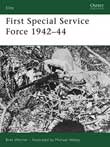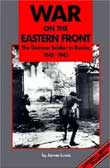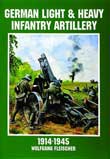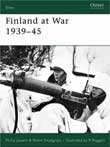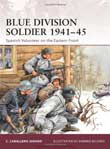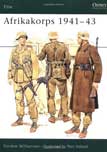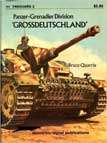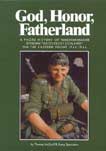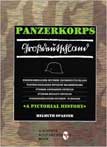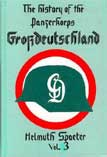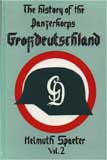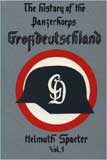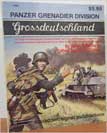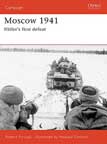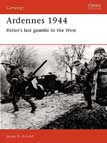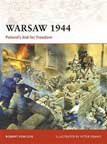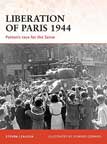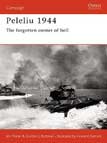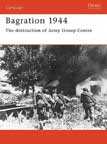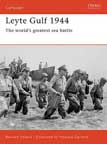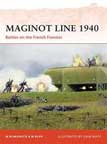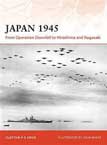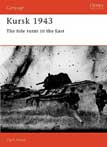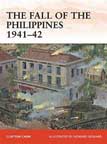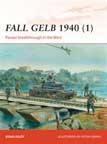

Osprey's examination of the First Special Service Force of the second half of World War II (1939-1945). This famous unit was formed with three battalions in July 1942, for special operations in occupied Norway, from handpicked US and Canadian volunteers who were trained in parachute, amphibious, ski, mountain and demolition operations and other 'Special Forces' skills. Their training base was Fort Harrison, Montana. In the event the Force first saw combat in Italy. There they distinguished themselves, at heavy cost, in the battles of La Difensa (Dec 1943), Mte Majo (Jan 1944), on the Anzio beachhead (Feb - May 1944) and in the race to Rome, which they actually liberated. Their uniforms, clothing and weaponry had many unique features reflecting their bi-national composition and specialist skills.
The FSSF fought with a ferocious skill which earned them a fearsome reputation. At Anzio, although at only half strength, they successfully held at least a quarter of the entire beachhead and were the spearhead of the final breakout towards Rome. Famed for their night-time fighting ability, the Germans named them "Die Schwartze Teuflen" the Black Devils (they blacked their faces with boot polish). However, after taking part in the South of France campaign in Aug - Nov 1944 the Force was disbanded, survivors passing to other units. 1,800 men at full strength, they had accounted for 12,000 enemy casualties, taken 7,000 prisoners and experienced a 600% attrition rate.
This book provides very interesting details on subjects rarely addressed on the Russian Front. I loved it. Much has been written about the tanks and infantry, but theis book teaches about the self propelled artillary, the rockets, staying warm, marching, terrain etc! This book is unashamed to detail the bravery, endurance, guile, skill and professionalism of the brave German soldier and his equally brave Russian foe. His writing style is excellent, the chapters and topics are short and sweet.
Reviewer: Mal Wright from Adelaide, South Australia.
This booklet, by Wolfgang Fleischer, is a bit misleading as the title leads one to expect more coverage of WW1. Instead it skips over the 1914-18 period and seems to use it more as an introduction to WW2. That is a shame as even though it does not mention many WW1 guns, those it does skip across are interesting weapons. After a couple of pages of fairly vague text on WW1 it goes into WW2 infantry guns in considerably more detail. Once again it is often tempting, but not very fulfilling. However the photographic coverage of WW2 Infantry guns is quite extensive. It should prove helpful to those wanting to model some of the weapons in detail and at the price is therefore a bargain. As a serious work on the subject, it is however lacking in technical data and comparisons. I give this booklet 3 stars for WW2 and would give it half a star for WW1. It is worth adding to your collection and won't break your budget.
The armies of Scandinavia and the Low Countries bore the first crushing impact of Hitler's mighty Blitzkrieg war machine in Western Europe, in campaigns that astonished and terrified the world.
The German Wehrmacht was millions strong, equipped with the latest guns, tanks and aircraft, and had the priceless advantage of having learned the realities of modern warfare in Poland the previous September. The defenders of Scandinavia and the Low Countries were raised from small populations, and were inadequately funded, trained, equipped and armed. Their modest numbers, inexperience, and largely indefensible borders condemned them to rapid defeat - in a few hours (Denmark), a few days (Holland), a couple of weeks (Belgium), and at most two months (Norway). For this reason they have tended to be neglected by history - in many cases, unjustly. Vastly outnumbered - and, in the case of the neutral Low Countries, with their potential French and British allies reeling under simultaneous attacks - thousands of soldiers fought heroically in the hopeless defence of their homelands against the Nazi juggernaut.
Tiny Denmark had only 6,600 troops when it was invaded on 9 April 1940 by six times as many Germans with air and tank support; resistance lasted only four hours. On the same day, mountainous Norway, with 25,000 men mainly scattered in small numbers along its cliff-bound coastline, was invaded by the first elements of seven German seaborne and airborne divisions totalling 100,000 men. A British, French and Free Polish force landed to support the Norwegians, but despite the serious casualties inflicted on the German forces the country was finally forced to surrender two months later on 9 June 1940.
In the mean time the massive German Operation Yellow, undertaken by 2.75 million troops backed by strong air forces, had fallen on the neutral Netherlands and Belgium (10 May), and on France (16 May). The 250,000 Netherlands troops put up unexpectedly stubborn resistance, but were ordered to surrender on 15 May after the German bombing of Rotterdam. Belgium had mobilised some 900,000 troops, and received some help from Britain and France, but the resistance faltered as Panzergruppe Von Kleist outflanked them through the supposedly impassable Ardennes; Belgium requested an armistice on 26 May, and surrendered on the 28th. Between 26 May and 4 June the survivors of the British Expeditionary Force were evacuated from Dunkirk. On 10 June the Germans crossed the Seine; the French government fled Paris on the 12th; on the 17th Marshal Pétain requested an armistice, and France finally capitulated on 22 June.
Informed by the latest research and drawing upon archival records and period photography, this absorbing study explains the organization and combat performance and depicts the appearance of the armies of Denmark, Norway, the Netherlands and Belgium as they sought to counter overwhelming German forces in the fateful spring of 1940.
Osprey's examination of Finland's involvement in World War II (1939-1945). Finland's fight to defend her independence earned this tiny nation of just 3 million people a distinct place in history. Invaded by Stalin before World War II, Finland held out for months and inflicted huge losses on the invaders, but she was eventually crushed by the weight of Soviet numbers. When Germany invaded the USSR in 1941 the Finns fought alongside the Wehrmacht on the northern Russian Front, with great skill and courage in an attempt to regain their lost territories. When the German armies were forced to retreat in 1944, Finland managed to conclude a separate peace with the USSR – uniquely, without being forced to accept renewed Russian occupation. This book details the organisation, uniforms and equipment of this remarkable force.
Osprey's survey of the Blue Division soldiers of World War II (1939-1945). The all-volunteer 'Blue Division' was a formation that allowed Franco's technically neutral Spain to support Nazi Germany's invasion of Russia. Following initial training in Germany, the Blue Division's units were sent to the Eastern Front in August 1941, where, after a 40-day march to the front, the Division fought in several major battles including Leningrad. In 1943, with the tide turning against the Axis forces in Russia, the Division was ordered to be withdrawn, yet many men chose to stay on and serve with the Volunteer Legion. Even after the collapse in the East, some volunteered to serve with Waffen-SS units through to the fall of Berlin in 1945. This book narrates the experiences of the common soldier, exploring his motivation for serving the Wehrmacht, and detailing his dramatic experiences in a brutal and hostile theater of World War II.
Osprey's study of the German Afrikakorps of World War II (1939-1945). The campaign in North Africa between September 1940 and May 1943 holds not only an enduring fascination for postwar generations; but also a perhaps unique degree of nostalgia for some surviving participants. The campaign was no less costly in terms of human lives and material than many others; but regret at the cost is accompanied by positive memories in the minds of many veterans. This is not to suggest that the dead have been forgotten; but an almost mystical bond nevertheless exists, even between former enemies, amongst veterans of the desert campaign. Gordon Williamson examines the history, organisation and uniforms of Rommel's Afrikakorps.
The battle for Guadalcanal that lasted from August 1942 to February 1943 was the first major American counteroffensive against the Japanese in the Pacific. The battle of Savo Island on the night of 9 August 1942, saw the Japanese inflict a sever defeat on the Allied force, driving them away from Guadalcanal and leaving the just-landed marines in a perilously exposed position. This was the start of a series of night battles that culminated in the First and Second battles of Guadalcanal, fought on the nights of 13 and 15 November. One further major naval action followed, the battle of Tassafaronga on 30 November 1942, when the US Navy once again suffered a severe defeat, but this time it was too late to alter the course of the battle as the Japanese evacuated Guadalcanal in early February 1943.This title will detail the contrasting fortunes experienced by both sides over the intense course of naval battles around the island throughout the second half of 1942 that did so much to turn the tide in the Pacific.
A "quickie" book that will give the reader a overview of Großdeutschland. Probably out of print.
Panzergrenadier Division "Grossdeutschland" was one of Germany's most celebrated military formations of the Second World War. Formed in 1942 by the expansion of Infantry Regiment (motorized) "Grossdeutschland," the new division quickly earned its reputation on the Eastern Front of being the elite of the German Army. Twice the size of most other divisions, it was an immensely powerful and hard-hitting mechanized formation that cut a large swath through the Red Army, whether in the attack or on the defense. Its carefully selected officer and non-commissioned officer corps ensured that no matter what the odds, the division would always give a good account of itself in battle and would possess an esprit de corps enjoyed by few other comparable divisions, including those of the Waffen-SS.
The thousands of volunteers from every land and province in Germany who fought and died while serving in the ranks of Panzergrenadier Division "Grossdeutschland" represented a cross-section of German society, a radical departure from the manner in which most German divisions of the era were created. Now for the first time, the faces of these men, at rest and in battle, can be seen through the images gleaned from hundreds of photographs taken by the division's war correspondents or Kriegsberichter.
This outstanding selection of photographs, which until recently remained unseen for decades in a European archive, have been recovered and painstakingly researched by authors Remy Spezzano and Thomas McGuirl. Together with the assistance of the division's Veterans' association, they identified hundreds of men, living and dead, as well as dozens of combat vehicles, items of equipment, and specific engagements the division took part in from April 1942 to September 1944. Accompanied by a detailed narrative that ties each of the photos within the context of the war on the Eastern Front, "God, Honor, Fatherland" represents a milestone in the study of the war in the East and shows the face of the German soldier as he has never been shown before.
German language edition. A companion to the above book, this volume is chock full o' GD photos. It is also available in English, but I know not where. Photo history of one of the most elite fighting units in WWII by one of its former members. Includes listing of Knights Cross Winners.
The absolute "last-word" on GD. Translated from the German, this book has every thing there is about GD and its offspring units. Hard cover, small format (6" x 9"), 507 pages, 30+ maps and diagrams. This is the third and final volume of the text history of this elite formation. Sections include: The creation of Panzer-Korps "Großdeutschland"; the complete history of the Brandenburgers as a commando unit; the history of Panzer-Grenadier-Division "Brandenburg"; the final fighting of both "Großdeutschland" and "Brandenburg"; the activation of additional "Großdeutschland" formations in the final, desperate fighting; the "Führer" Divisions on the Eastern Front; the Panzer-Grenadier-Division "Kurmark". Each section is filled with detailed, first-hand accounts from the participants. The author is Knight's Cross recipient Helmut Spaeter.
The absolute "last-word" on GD. Translated from the German, this book has every thing there is about GD and its offspring units. Hard cover, small format (6" x 9"), 494 pages, 20 maps. Volume 2 covers the "GD" from late 1942 until early 1945. It includes extensive details on affiliated units such as Kurmark, Brandenburg and the Führer-Begleit-Brigade. Lots of first-hand descriptions and small-unit actions.
The absolute "last-word" on GD. Translated from the German, this book has every thing there is about GD and its offspring units. Hard cover, small format (6" x 9"), 479 pages, many maps and orders of battle. The first volume of a 3-volume set covers the "GD" (Greater Germany) from its inception as a "Wach"-Regiment in 1921 through its evolution into an infantry regiment. Covered are the unit's first action in France in 1940 and its reorganization as a Panzergrenadier-Division. This volume covers the regiment/division through to the end of 1942. An excellent history of one of the most elite units of the German army.
In both German and English, this book is one of the "classics" and also a good reference work on the unit. It has a timeline and many photos and maps. Covers the WWII German units including - Panzer Grenadier Division 'Grossdeutschland' and Panzer-Korps Grossdeutschland; Panzer Division Brandenburg; Führer Grenadier Division, Führer Begleit Division and Panzer Division Kurmark. Nicely illustrated in B&W photos and maps.
Suffering a staggering loss of over 2 million troops by September 1941, Soviet forces were faced with the prospect of Hitler victoriously re-directing his powerful German armies toward the heart of Soviet Russia - Moscow. However, the season was late and the Germans found themselves in a race to launch a final decisive attack before the arrival of the dreaded Russian winter. Stalin desperately sought to play for time by mustering all available military resources to save his capital.?This book is the story of Operation Typhoon, the largest German operational attack of the war and Hitler's desperate attempt to seize Moscow. With expert knowledge of the subject, author Robert A. Forczyk successfully manages to bring to life the battle which saw the most horrific losses for the Soviet defending forces and marked the first defeat of the Wehrmacht.
The fighting around the town of Demyansk was one of the longest encirclement battles on the Eastern Front during World War II, stretching from February 1942 to February 1943. Originally, the German 16. Armee occupied Demyansk in the autumn of 1941 because it was key terrain that would be used as a springboard for an eventual offensive into the Valdai Hills. Instead, the Soviet winter counteroffensive in February 1942 encircled the German II Armeekorps and other units, inside the Demyansk Pocket. Yet despite severe pounding from five Soviet armies, the embattled German troops held the pocket and the Luftwaffe organized a major aerial resupply effort to sustain the defenders. For the first time in military history, an army was supplied entirely by air. In February 1943, Marshal Timoshenko was ordered to launch an offensive to cut off the base of the salient and annihilate the 12 divisions. At the same time, Hitler finally came to his senses after the Stalingrad debacle and authorized the 16. Armee to withdraw from the pocket. This volume will conclude with the drama of a German Army-sized withdrawal under fire in winter, under attack from three sides.
The 'Battle of the Bulge' was the last major German offensive in the West. Three armies attacked through the Ardennes, the weakest point in the American lines - and almost broke through. This title describes the planning of the attack and the course of events, including the defence of Bastogne and the heroic delaying actions fought by GIs supposed to be in a 'quiet' sector of the front. In spite of serious American disadvantages Hitler's offensive was stopped. James Arnold explains exactly how this was achieved, and how Germany's last hopes of victory were finally put to rest.?Campaigns 5, 24, 74 and 75 are also available in a single volume special edition as 'Into the Reich'.
Defeated and occupied in 1939, Poland had suffered under the Nazi heel for nealy five years. Undaunted, however, the Poles formed an underground army, the Armia Krajowa (Home Army), and waited for a moment of German weakness. That moment seemed to have arrived in July 1944 as the Soviet armies began to advance into eastern Poland. The AK launched its revolt in Warsaw on 1 August 1944. Though its 5,000 fighters achieved some initial successes, the Germans were able to retain control over both the Vistula River bridges and the airbase, dooming the revolt to isolation and defeat. The SS was put in charge of suppressing the rebellion, beginning a wave of atrocities shocking even by Eastern Front standards.
In July 1944, Operation Cobra broke the stalemate in Normandy and sent the Allies racing across France. The Allied commanders had ignored Paris in their planning for this campaign, considering that the risk of intense street fighting and heavy casualties outweighed the city's strategic importance. However, Charles de Gaulle persuaded the Allied commanders to take direct action to liberate his nation's capital. Steven J Zaloga first describes the operations of Patton's Third Army as it advanced towards Paris before focussing on the actions of the Resistance forces inside the city and of the Free French armoured division that fought its way in and joined up with them to liberate it on the 24th August. On the back of this morale-boosting victory, De Gaulle could finally proclaim Paris to be liberated, as one of the world's loveliest cities survived Hitler's strident command that it should be held at all costs or razed to the ground.
The German victory of 1940 stunned the world. France, major European power and owner of the world's largest armies had fallen in less than seven weeks to the might of the German Wehrmacht. The secret of the Wehrmacht's success lay in its carefully thought out organization and the tactics of blitzkrieg. Fast moving tank divisions supported by armoured, mobile infantry swept over opposition, helped by both conventional bombers and deadly Stuka dive-bombers. Alan Shepperd's highly detailed text examines the tactics, organization and equipment of the Allied and German forces, and provides a daily account of the most crucial period of the battle.
On 8th December 1941, as part of the simultaneous combined attack against Pearl Harbor, the Imperial Japanese Army (IJA) invaded the Philippines, Thailand and Malaysia and the British colony of Hong Kong. After only 18 days of battle the defenders, a weak, undermanned brigade, were overwhelmed by a superior force of two battle-hardened IJA divisions. What defines the battle of Hong Kong was not the scale—just 14,000 defended the colony - but the intensity of this battle, fought not only by the British Army, Navy and Air Force but also Canadians, Hong Kong's own defence force, the Indian Army and many civilians. The campaign itself is characterized by a fierce land battle, with long artillery duals and as well as fast naval actions with intense actions at the Gin Drinkers Line as well as the battle of Wong Nai Chung Gap where a handful of defenders took on an entire Japanese regiment. Less known but equally important are individual acts valour such as CSM John Robert Osborne winning a posthumous VC, throwing himself over a Japanese grenade to save fellow combatants.
Equalling Tarawa, Iwo Jima and Okinawa in scale and ferocity, the battle for Peleliu has long been regarded as the Pacific War's "forgotten battle", and perhaps one that should never have been fought. A massive carrier-based attack some weeks before the invasion destroyed all aircraft and shipping in the area and virtually isolated the Japanese garrison. 1st Marine Division commander, General Rupertus, made extravagant claims that the capture of Peleliu would "only take three days - maybe two." But the Japanese fought a bloody battle of attrition from prepared positions an in a struggle of unprecedented savagery a whole Marine Division was bled white.
On 22 June 1944, three years to the day after Germany's 1941 invasion of the Soviet Union, the Red Army launched a massive offensive in Byelorussia. Codenamed 'Operation Bagration', this campaign climaxed five weeks later with the Red Army at the gates of Warsaw. The Wehrmacht's Army Group Centre was routed, a total of 17 Wehrmacht divisions were utterly destroyed, and over 50 other German divisions were shattered. It was the most calamitous defeat of the German armed forces in World War II.
Leyte Gulf was a key victory for the United States: its scale dwarfed previous sea conflicts and its outcome created an opportunity for the US forces to invade the Philippines. Four different battles - Leyte, Samar, Cape Engano and the Suriago Strait - occured almost simultaneously as past of a Japanese plan to claim a Trafalgar-style victory over the US forces. Yet they were defeated in the battles on the surface, under the sea, and in the air. This highly accessible book describes the conflict's interweaving battles and the personalities of the commanders involved in what has been called 'the greatest sea battle of all'.
Operation Pointblank was the code name for the United States Army Air Force's attempt to destroy German fighter capability through the use of daylight strategic bombing in advance of the D-Day landings. Launched in 1943, the operation immediately met with severe problems, most notably the horrible attrition experienced by the US bomber forces. However, with the arrival of the P-51 Mustang, the United States was able to equip the fighters to fly on long-range-bomber escort missions and take the fight to the Luftwaffe in the skies over Germany. This book examines the entire operation from both the Allied and the German perspectives, covering all the main decisions and technological innovations made by both sides in this epic struggle.
The raid on the port of St Nazaire in March 1942 by a sea-borne task force from British Combined Operations remains one of the most daring actions of World War II. The port lies at the mouth of the River Loire and in 1942, as well as a U-Boat base, contained the massive 'Normandie' dock, the only facility on the Atlantic coast large enough to accommodate the German pocket battleship Tirpitz. This book tells the story of the raid on St Nazaire that denied the use of the dock to the Tirpitz, the sister ship of the Bismarck, and constituted a crucial victory in the Battle of the Atlantic.
Constructed throughout the 1930s, the Maginot Line was supposed to form the ultimate defence against a German invasion of France. However, different sections of the line were built at different times and the strength of various sections varied widely. During their Blitzkrieg invasion, the Germans were able to identify these weak points and focus their attacks against them. ?This book uses new maps and period photographs to tell the story of the five German operations launched against the Maginot Line. While the Germans were able to smash through the lightly defended section of the line along the Meuse River, at other points the line held. Although ultimately the Maginot Line was to prove a failure, the stiff resistance put up by some of the fortresses confirms the fighting ability of the French army during the invasion.
Hitler's protracted siege of Leningrad resulted in one of the most brutal campaigns on the Eastern Front during World War II. The German Army Group North was able to isolate the city and its garrison for a period of 900 days, during which an estimated 1.5 million Soviets died from combat, disease and starvation. For over two years, German forces pounded the city with artillery and air assaults while the Soviets made repeated efforts on the frozen swamplands of the Volkhov Front to break through. Finally, in January 1944, the Soviets were able to break Army Group North's front and relieve Leningrad. While most histories of the siege of Leningrad focus on the plight of the starving civil population, this refreshing title instead examines the strength of the garrison's defenses - which ultimately prevented the Germans from capturing the city - and the growing sophistication of Soviet offensive tactics. Dr Forczyk also provides an assessment of how weather and terrain factors shaped the campaign in this superb addition to the history of the Eastern Front.
By the spring of 1945 the Allies were sweeping all before them in the Pacific War against Japan, and a series of victories had reclaimed many of the islands and territories seized by the Imperial Japanese forces in the early months of the war. The dark days of humiliating defeat were far behind the unstoppable Allied juggernaut - victory was now assured. The question was where the last battle would be fought. That place was the island of Okinawa. This book details the struggle for the island as US Marines and Army units battled determined Japanese defenders in the last battle of World War II.
Following the capture of Tarawa in November 1943, American eyes turned to the Marshall Islands. These were the next vital stepping-stone across the Pacific towards Japan, and would bring the islands of Guam and Saipan within the reach of US forces. In their first amphibious attack, the new 4th Marine Division landed on Roi and Namur islands on 1 February 1944, while US 7th Division landed on Kwajalein. At the time this was the longest shore-to-shore amphibious assault in history. The lessons of the bloody fighting on Tarawa had been well learned and the successful attack on the Marshalls set the pattern for future amphibious operations in the Pacific War.
In the aftermath of the Battle of the Bulge in February 1945, the Allies embarked upon the final assault of Germany. The long-delayed US thrust over the Roer River eventually took place in February, leaving the Rhine as the last major geographical barrier to the Allied advance into Germany. ?This book describes how the US Army, in the face of furious last-ditch German resistance, captured the Ludendorff Bridge at Remagen - securing the last surviving major crossing over the Rhine and setting the stage for the defeat of the German Army in the West.
Following a lull in the desert war which saw the Germans and British reinforce their armies, Rommel suddenly attacked British fortifications with an assault on the northern sector of the British line near Gazala. Pinning down the British in the north and outflanking the 1st Free French Brigade, Rommel succeeded in encircling the main British positions, trapping them in what became known as 'The Cauldron'. With thousands of British soldiers killed or taken prisoner, this was a devastating defeat for the Allies. Accompanied by contemporary photographs and maps depicting the movement of both armies, Ken Ford provides a masterful study of Rommel, the 'Desert Fox', at the height of his powers as he swept the British army back to the site of their final stand at El Alamein.
Despite myth, the Japanese carrier force was not destroyed at Midway but survived to still prove a threat in the Pacific Theater. Nowhere was this clearer than in the battle of Santa Cruz of October 1942. The stalemate on the ground in the Guadalcanal campaign led to the major naval forces of both belligerents becoming inexorably more and more involved in the fighting, each seeking to win the major victory that would open the way for a breakthrough on land as well. The Japanese were able to gain a tactical victory at Santa Cruz and came very close to scoring a strategic victory, but they paid a very high price in aircraft and aircrew that prevented them from following up their victory. In terms of their invaluable aircrew, the battle was much more costly than even Midway and had a serious impact on the ability of the Japanese to carry out carrier warfare in a meaningful manner.
Operation Dragoon, the Allied landings in southern France on August 15, 1944, was one of the most controversial operations of 1944, leading to a deep divide between United States and British planners. The US objective was to threaten the rear of the German armies occupying France by a landing on the eastern French coast and to push rapidly northward towards Lorraine to meet up with Allied forces bursting out of Normandy. ?Popular Osprey author Steve Zaloga tells the story of this ultimately successful operation, from the derisive debates between the Allied commanders to the men who hit the beaches and charged ashore to help liberate occupied France.
ALSO AVAILABLE TO BUY AS AN E-BOOK In this 200th Campaign series title Clayton Chun examines the final stages of World War II as the Allies debated how to bring about the surrender of Japan. He details Operation Downfall (the planned invasion of the Japanese home islands).Chun explains why these plans were never implemented, before examining the horrific alternative to military invasion - the attacks on Hiroshima and Nagasaki with nuclear weapons. With a series of illustrations, including detailed diagrams of the atomic bombs, a depiction of the different stages of the explosions and maps of the original invasion plans, this book provides a unique perspective of a key event in world history.
On what was a virtually unheard of Pacific island, the United States shattered the myth of Japanese invincibility. In the first American amphibious assault of the Second World War, the US Marines and Army halted the apparently irresistible Japanese advance in its tracks. Over 30,000 American and Japanese casualties were suffered in five months of bitter fighting. From the ranks of the units that contested this campaign a seasoned fighting force of US veterans was created that would, island by island, sweep the Japanese back across the Pacific.
Immortalized by the movie A Bridge Too Far, the parachute landings of the 82nd and 101st Airborne Divisions were the first part of an Allied breakthrough attempt. In the late summer of 1944, the First Allied Airborne Army began to plan a complex operation to seize a Rhine River Bridge at Arnhem in the Netherlands. The airborne mission was code-named Operation Market, and the ground assault was designated Garden. The American portion of Operation Market was to employ the two divisions of Gen. Matthew Ridgway's US XVIII Airborne Corps to seize key terrain features that might otherwise delay the advance of British tank columns towards the ultimate objective of the Rhine bridge at Arnhem. The plan envisioned landing the US 101st Airborne Division near Eindhoven to clear a path for the advance of the armored divisions of the British XXX Corps, and to land the 82nd Airborne Division around Nijmegen to seize the Waal river bridges there. In view of the problems experienced in Normandy with night landings, Operation Market was scheduled to take place on the afternoon of September 17th, 1944, with an elaborate tactical air plan to suppress German flak positions.
The initial 101st Airborne Division conducted its combined parachute/glider landings on the afternoon of September 17th, 1944, using its three Parachute Infantry Regiments (PIR). The 82nd Airborne Division was dropped further northeast with its three regiments having separate assignments. Overall, the first day's operation was a considerable success compared to the Normandy drops. The Wehrmacht did not anticipate the airborne attack so resistance on the first day was light. The fighting intensified dramatically over the next several days as the Germans attempted to stamp out the landings, attacking the Allied forces on all sides of the salient.
The 101st Airborne Division pressed south towards Eindhoven on the morning of September 18th, while the British Guards Armoured Division pressed north. The paratroopers captured the city by early afternoon and linked up with the British tanks in the evening. After quickly bridging the Wilhelmina canal in the dark, the Guards Armored Division crossed around dawn on September 19th and raced up to the 82nd Airborne Division sector by 0820. Combined British and American attacks to seize the vital Nijmegen bridge were repulsed through September 19th due to the arrival of elements of the 10.SS-Panzer Division from the Arnhem area. But in a bold move, the 82nd Airborne outflanked the defenses on the afternoon of September 20th by using boats to cross a mile downstream from the bridge. Last minute German attempts to detonate the bridge failed, and British tanks were streaming over the bridge that night, heading for Arnhem.
Nevertheless, the delays caused by the initial defense at Eindhoven, the need to build a bridge at Son, and the fighting for the bridge at Nijmegen slowed the advance by XXX Corps and put it behind schedule. German resistance against the 1st Airborne Division in Arnhem was far fiercer than anticipated due to the unexpected presence of two Waffen-SS panzer divisions refitting in the area. The positions of the British 1st Airborne Division at Arnhem proved untenable and permission to withdraw was given on September 25th with the action taking place on the night of September 25-26th.
Osprey's examination of the Kursk campaign of World War II (1939-1945). In the summer of 1943 the German army stood poised for a major offensive. The attack was aimed at the Kursk salient, which the Germans intended to isolate, trapping large numbers of Russian troops and paving the way for the decisive campaign to knock the Soviet Union out of the war. By the time of the attack, the Russians had turned the salient into a mass of defensive positions. In the following decisive clash, the Soviets bled Germany's vital Panzer forces white and finally took the initiative. The counter-offensive which followed began an advance that would end in the ruins of Berlin.
The Philippine Islands were one of two major US bases in the Pacific, the other being Pearl Harbor. The Japanese considered the capture of the Philippines crucial for its efforts to control resource-laden Southeast Asia. As opposed to its attack on Pearl Harbor, the Japanese intention was to invade and occupy the Philippines in a campaign that was to last five months.
The flamboyant Douglas MacArthur, a hero of World War I and former Chief of Staff led the defense of the Philippines when the Japanese attacked on 8 December 1941. Despite warnings about the Pearl Harbor attack, the Japanese air forces caught MacArthur's aircraft on the ground resulting in half of his modern bomber and fighter aircraft destroyed. Army Air Forces B-17s attempted to bomb Formosa, but Japanese fighters eliminated them and a Japanese full-scale invasion followed days later.
Japanese forces landed in northern Luzon from Formosa. B-17s and naval attacks tried in vain to stop the invasion, but failed. Poorly trained and equipped Philippine Army units could not halt the Japanese and the American and Filipino forces withdrew, even though they outnumbered the initial Japanese forces. Japanese Army units broke through several defensive lines as they drove on to Manila, which was abandoned by the Americans as Macarthur withdrew to Bataan. The Japanese gradually reduced this pocket until the only American position was Corregidor Island. MacArthur left for Australia, as a direct order from President Franklin Roosevelt and was awarded the Medal of Honor, one of the more controversial aspects of the campaign. With little hope of survival, Corregidor fell, with organized resistance ending on 9 May 1942.
Although a defeat, the American and Filipino defensive efforts upset the Japanese plan for a swift victory and provided time for Australia and the United States to build up their defenses. It also gave hope to the American public that Americans could stand up to Japan, with the "Battling Bastards of Bataan" providing a source of inspiration. Unfortunately, for the survivors of the campaign, it meant a grueling three years of captivity for some. The Bataan Death March was one of the most infamous events in World War II, with Japanese forces responsible for the deaths of about 600 Americans and between 5,000-10,000 Filipino soldiers dying in the march, some summarily executed by beheading.
The German blitzkrieg conquest of France and the Low Countries (via the Ardennes, Arras, and Dunkirk) in May and June of 1940 has never been surpassed in the history of warfare in that no clash between such great and apparently equal forces has been decided so swiftly and conclusively. Not deigning to spend itself against the extensive fortifications of France's Maginot Lines, Hitler's Wehrmacht planned to advance its 136 (of 157) divisions through Belgium and northern France in order to destroy the Allied forces there and gain territory from which to prosecute continued combat operations against France and England. Beginning on 10 May 1940, this title follows the fortunes of Heeresgruppe A as its three Panzer Korps moved stealthily through the dark, hilly, and thickly forested Ardennes in southern Belgium before forcing a passage across the river Meuse and racing through France to the Channel in one of the most daring campaigns in history.
Pope Julius II excommunicates Italian state of Venice
Treaty of St. Truiden: anti-French Trapdoors / Bourgondisch covenant
Battle at Bicacca: Charles I and Pope Adrianus VI beat France
Mogol King Babur beats Sultan of Delhi
1st Spanish settlement in Philippines, Cebu City, forms
Peace of Beaulieu and Paix de Monsieur
King Charles I flees Oxford
Scottish general Montrose defeated
Netherlands and France sign military covenant
Frederik August I "the Strong" becomes Monarch of Saksen
Battle at Culloden Moor: Duke of Cumberland beats "James VIII & III"
US Marines attack shores of Tripoli
Americans under General Pike capture Toronto; Pike is killed
Fire destroys half of Charleston
Imakita Kosen, 1st Zen teacher of D.T. Suzuki, found the awakening
Establishment of Jewish congregations in Lower Austria prohibited
"Pomona" sinks in North Atlantic drowning all 400 aboard
Thomas J Jackson is assigned to command Harpers Ferry
President Abe Lincoln suspends writ of habeas corpus
West Virginia secedes from Virginia after Virginia secedes from US
Cornell University (Ithaca NY) is chartered
Heinrich Schliemann discovers Troi
White League, Paramilitary white supremacist organization, forms
Opera "Le Roi de Lahore" is produced (Paris)
President Hayes removes Federal troops from LA, Reconstruction ends
Pogroms against Russian Jews start in Elisabethgrad
1st Highlander (Yankee) shut-out, Philadelphia Athletics win 6-0
World Exposition opens in Luik
Sultan of Turkey Abdul Hamid II is overthrown
Belgian parliament rejects socialist motion for general voting rights
Relief laws replaces those of 1854, in the Netherlands
Pogrom leader Petljoera declares Ukraine Independence
Hadjememaar, [Corn de Gelder] elected in Amsterdam
Fritz Langs "Dr Mabuse, der Spieler" premieres in Berlin
Yakut ASSR formed in Russian SFSR
Mussolini government italian place in South Tirol / Alto Adige
Antwerp soccer tie Belgium-Netherlands 1-1
Karl Jansky reports reception of cosmic radio signal in Washington DC
Yanks pull a 1st inning triple-play and beat Philadelphia Athletics 9-8
1st US social security payment made
US Social Security system makes its 1st benefit payment
Himmler orders establishment of Auschwitz Concentration Camp
German troops occupy Athens Greece
Belgium Jews are forced to wear stars
Tornado destroys Pryor Oklahoma killing 100, injuring 300
Lou Jansen and Jan Dieters arrested, lead illegal CPN party in Holland
Soviet Union breaks contact with Polish government exiled in London
Boston Brave Jim Tobin no-hits Brooklyn Dodgers, 2-0
2nd Republic of Austria forms
Italian partisans capture Mussolini prisoner
US 5th army enters Genua
1st radar installation aboard a coml ship installed
Babe Ruth Day celebrated at Yankee Stadium and through out US
Arab legion attacks Gesher bridge on Jordan River
"Tickets, Please" opens at Coronet Theater NYC for 245 performances
South Africa passes Group Areas Act segregating races
Mohammed Mossadeq chosen Premier of Persia
"4 Saints in 3 Acts" closes at Broadway Theater NYC after 15 performances
1st general elections in British Guyana, won by Jagans PPP
Wrestler Freddie Blassie coins term "Pencil neck geek"
Heavyweight champ, Rocky Marciano, retires undefeated from boxing
"Today" show goes abroard 1st time (Paris France)
Liu Sjau-chi elected President of China PR
1st atomic powered electric-drive submarine launched (Tullibee)
South Korean President Syngman Rhee resigns
Togo (formerly French Togo) declares independence from French adm
NASA launches Explorer 11 into Earth orbit to study gamma rays
NFL officially recognizes Hall of Fame in Canton, Ohio
Sierra Leone declares independence from the UK
"Jopie" Pengel forms government in Suriname
Cuban Premier Fidel Castro arrives in Moscow
RC Duncan patents "Pampers" disposable diaper
Dmitri Shostakovitch completes his 2nd cello concert
Rocky Marciano retires as undefeated boxing champ
"Education of Hyman Kaplan" closes at Alvin NYC after 28 performances
Baltimore Oriole Tom Phoebus no-hits Boston, 6-0
Congress of Political Party Radicals (PPR) forms in the Netherlands
Carol Mann wins LPGA Raleigh Ladies Golf Invitational
Curt Flood resigns Senators after 13 games and departs for Denmark
Apollo 16 returns to Earth
New York City Mayor John Lindsey appeals that John Lennon not be deported
Kansas City Royal Steve Busby no-hits Detroit Tigers, 3-0
Pan Am 707 crashes into mountains of Bali, killing 107
Sandra Haynie wins LPGA Charity Golf Classic
"So Long 174th St" opens at Harkness Theater NYC for 16 performances
Arabic Monetary Fund established in Abu Dhabi
Bloody riots in Soweto South Africa
HCC, Hobby Computer Club, forms in the Netherlands
Accident at nuclear reactor Willow Island, W Virginia, kills 51
George Harrison releases "Love Comes to Everyone"
Barbara Barrow wins LPGA Birmingham Golf Classic
1st female soccer official is hired by NASL
Beatle Ringo Starr marries actress Barbara Bach [Goldbach]
Nordiques 1-Isles 4 - Semifinals - Isles hold 1-0 lead
Trial of John W Hinckley Jr attempted assassin of Reagan, begins
Nolan Ryan becomes strikeout King (3,509), passing Walter Johnson
Cleveland Indians beat Detroit Tigers, 8-4, in 19 innings
Over 70 inches of snow falls on Red Lake, Montana
"Sweet Charity" opens at Minskoff Theater NYC for 368 performances
Captain Midnight (John R MacDougall) interrupts HBO
Pat Bradley wins LPGA S&H Golf Classic
US Justice Department bars Austrian Chancellor Kurt Waldheim from entering US, due to his aid of Nazi Germany during WWII
"Starmites" opens at Criter Ctr SR Theater NYC for 60 performances
Beijing students take over Tiananmen Square in China
Hurricane in Bangladesh, kills 500
Mandatory seatbelt law goes into effect in Italy
50th annual barbershop quartet singing convention held (Mich)
Dodger Orel Hershiser undergoes career-threatening shoulder surgery
Firestone World Bowling Tournament of Champions won by David Ozio
"Small Family Business" opens at Music Box Theater NYC for 48 performances
New York Jets finish perfect 5-0 pre-season for 1st time
New York Mets trade David Cone to Toronto Blue Jays for Jeff Kent
Afghan Antonov AN-32 crashes at Tashqurgan, kills 76
"Inspector Calls" opens at Royale Theater NYC for 454 performances
7th longest NHL game: New Jersey Devils beat Buffalo Sabres (125 min 43 seconds)
Graeme Obree bicycles world record time (52,713 km)
President Nixon buried in Nixon Library in California
Twins righty Scott Erickson no-hits Brewers 6-0
"Indiscretions" opens at Ethel Barrymore Theater NYC for 221 performances
Coors Field in Colo opens - Denver Rockies beats Mets 11-9 in 14
"Little Foxes, " opens at Vivian Beaumont NYC for 56 performances
"Stanley, " closes at Circle in the Square Theater, New York City
Frank Nobilo wins Greater Greensboro Chrysler Classic at Forest Oaks
Las Vegas Senior Golf Classic by TruGreen-ChemLawn
Nancy Lopez wins LPGA Chick-fil-A Charity Championship
